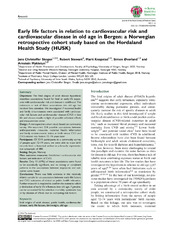Early life factors in relation to cardiovacular disease in old age in Bergen: a Norwegian retrospective cohort study based on the Hordaland Study (HUSK)
Skogen, Jens Christoffer; Stewart, Robert; Knapstad, Marit; Øverland, Simon Nygaard; Mykletun, Arnstein
Peer reviewed, Journal article
Published version
Permanent lenke
https://hdl.handle.net/1956/9197Utgivelsesdato
2014-07Metadata
Vis full innførselSamlinger
Originalversjon
https://doi.org/10.1177/2054270414527935Sammendrag
Objectives: The fetal origins of adult disease hypothesis describes associations found for fetal or early-life expos- ures with cardiovascular risk and disease in adulthood. The extension or not of these associations into old age has received less attention. We investigated if maternal health and family circumstances were associated with cardiovas- cular risk factors and cardiovascular disease (CVD) in late life and discuss results in light of possible selection effects and measurement error. Design: A retrospective cohort study based on community survey. We examined 224 possible associations between anthropometric measures, maternal health information and family socioeconomic status at birth versus CVD and CVD-related risk factors 72–74 years later. Participants: Of 3341 participants in a community survey of people aged 72–74 years, we were able to trace birth records from a historical archive in a broadly representa- tive subsample of 480. Setting: Bergen, Norway Main outcome measures: Established cardiovascular risk factors and indicators of CVD. Results: Only 11 (4.9%) of these associations were found to be statistically significant, and no strong or consistent patterns in the associations between exposures and out- comes were found. <strong<Conclusions: There was little evidence in this relatively elderly sample for an association between early life factors and CVD outcomes of clinical or public health relevance. Further research is required to confirm the extent to which a diminution of early life influences into old age, if genuine, can be accounted for by selective mortality, systematic bias or by dilution of effects due to competing risk factors.

